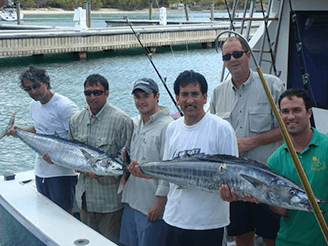Wahoo Fishing in Miami
Miami, a city known for its stunning landscapes, vibrant culture, and bustling nightlife, also boasts some of the most exhilarating fishing experiences in the United States, particularly when it comes to the elusive and speedy Wahoo. Wahoo fishing in Miami offers an adrenaline-pumping adventure for anglers of all levels, promising not only the thrill of the chase but also the satisfaction of landing one of the fastest fish in the ocean. Let’s embark on a journey to uncover the excitement of Wahoo fishing in Miami and how you can secure the catch of a lifetime.
 Wahoo: The Speedster of the Sea
Wahoo: The Speedster of the Sea
Wahoo (Acanthocybium solandri) is a prized catch for sport fishermen due to its incredible speed, agility, and the culinary delight it offers. Known for striking hard and fast, Wahoo can reach speeds up to 60 mph, making them a challenging and rewarding target. These sleek, silver-blue fish are not only a testament to your angling skills when caught but also provide a delicious reward for your efforts, with their firm, white flesh being highly valued in culinary circles.
When and Where to Fish for Wahoo in Miami
The waters around Miami are a hotspot for Wahoo, especially during the cooler months from November through March when these fish are most abundant and active. Wahoo are often found near the edge of the Gulf Stream, where deep waters meet the warm currents, creating the perfect habitat for these speedsters. Key areas include offshore waters where trolling is a highly effective technique for attracting Wahoo. Early morning or late afternoon, when the sun is not at its peak, is considered the ideal time for Wahoo fishing, capitalizing on their predatory instincts.
Gear and Techniques for a Thrilling Catch
Tackling a Wahoo requires specific gear and techniques due to their power and speed. High-speed trolling with heavy-duty gear is the most effective method to entice a Wahoo to bite. A sturdy rod and reel combo capable of handling 50 to 100-pound test line is essential, paired with high-speed lures or live bait such as bonito or mackerel to mimic their natural prey. The thrill of the catch lies in the initial strike and the ensuing battle, where the Wahoo’s speed and power are fully displayed.
Your Wahoo Fishing Adventure Awaits with Fish Jumanji
Embarking on a Wahoo fishing adventure in Miami requires local knowledge and expertise to ensure a successful and enjoyable experience. This is where Fish Jumanji Charters comes in, offering expertly guided fishing charters tailored to targeting Wahoo. With Fish Jumanji, you’ll have access to top-of-the-line gear, boats equipped for high-speed trolling, and seasoned captains who know exactly where to find these elusive fish.
Book Your Wahoo Fishing Trip
Fish Jumanji’s charters are designed to cater to both novice and experienced anglers, ensuring everyone aboard has a memorable and thrilling fishing experience. From choosing the right lures to mastering the art of high-speed trolling, the Fish Jumanji team will guide you every step of the way, setting the stage for the ultimate Wahoo fishing adventure. Book your charter today and prepare to reel in the catch of a lifetime.

 Wahoo: The Speedster of the Sea
Wahoo: The Speedster of the Sea